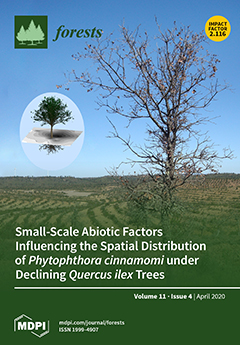Research Highlights: This study is the first to examine the genetic diversity of
Michelia shiluensis (Magnoliaceae). High genetic diversity and low differentiation were detected in this species. Based on these results, we discuss feasible protection measures to provide a basis for the
[...] Read more.
Research Highlights: This study is the first to examine the genetic diversity of
Michelia shiluensis (Magnoliaceae). High genetic diversity and low differentiation were detected in this species. Based on these results, we discuss feasible protection measures to provide a basis for the conservation and utilization of
M. shiluensis.
Background and Objectives:
Michelia shiluensis is distributed in Hainan and Guangdong province, China. Due to human disturbance, the population has decreased sharply, and there is thus an urgent need to evaluate genetic variation within this species in order to identify an optimal conservation strategy.
Materials and Methods: In this study, we used eight nuclear single sequence repeat (nSSR) markers and two chloroplast DNA (cpDNA) markers to assess the genetic diversity, population structure, and dynamics of 78 samples collected from six populations.
Results: The results showed that the average observed heterozygosity (Ho), expected heterozygosity (He), and percentage of polymorphic loci (PPL) from nSSR markers in each population of
M. shiluensis were 0.686, 0.718, and 97.92%, respectively. For cpDNA markers, the overall haplotype diversity (Hd) was 0.674, and the nucleotide diversity was 0.220. Analysis of markers showed that the genetic variation between populations was much lower based on nSSR than on cpDNA (10.18% and 77.56%, respectively, based on an analysis of molecular variance (AMOVA)). Analysis of the population structure based on the two markers shows that one of the populations (DL) is very different from the other five.
Conclusions: High genetic diversity and low population differentiation of
M. shiluensis might be the result of rich ancestral genetic variation. The current decline in population may therefore be due to human disturbance rather than to inbreeding or genetic drift. Management and conservation strategies should focus on maintaining the genetic diversity in situ, and on the cultivation of seedlings ex-situ for transplanting back to their original habitat.
Full article





